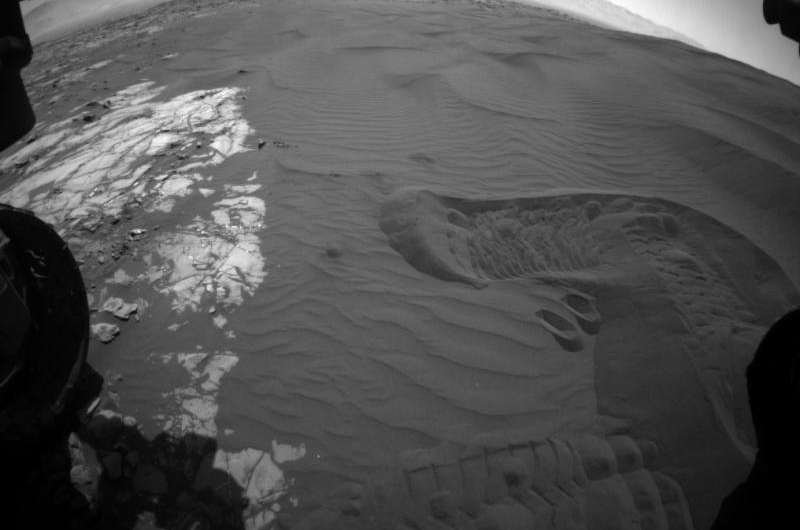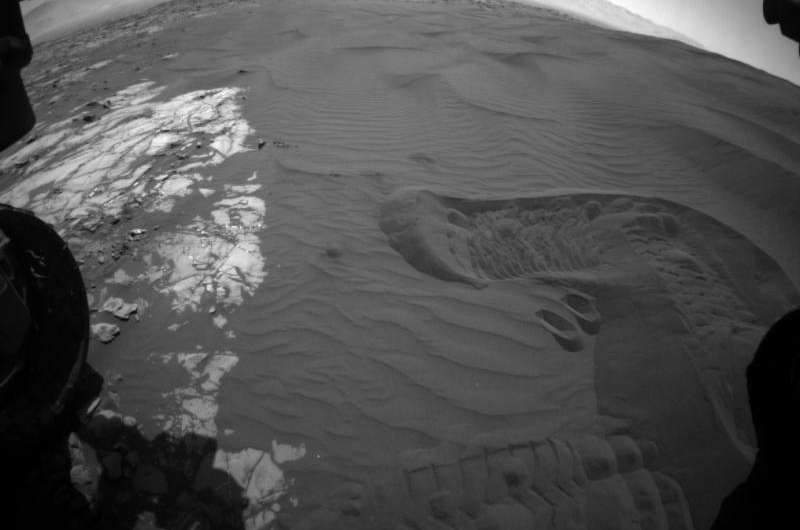Mars rover Curiosity tastes scooped, sieved sand

At its current location for inspecting an active sand dune, NASA's Curiosity Mars rover is adding some sample-processing moves not previously used on Mars.
Sand from the second and third samples the rover is scooping from "Namib Dune" will be sorted by grain size with two sieves. The coarser sieve is making its debut, and using it also changes the way the treated sample is dropped into an inlet port for laboratory analysis inside the rover.
Positioning of the rover to grab a bite of the dune posed a challenge, too. Curiosity reached this sampling site, called "Gobabeb," on Jan. 12.
"It was pretty challenging to drive into the sloping sand and then turn on the sand into the position that was the best to study the dunes," said Michael McHenry of NASA's Jet Propulsion Laboratory, Pasadena, California. He is the Curiosity mission's campaign rover planner for collecting these samples.
Curiosity has scooped up sample material at only one other site since it landed on Mars in August 2012. It sampled dust and sand at a windblown drift site called "Rocknest" in October and November 2012. Between there and Gobabeb, the rover collected sample material for analysis at nine rock targets, by drilling rather than scooping.

The mission's current work is the first close-up study of active sand dunes anywhere other than Earth. Namib and nearby mounds of dark sand are part of the "Bagnold Dune Field," which lines the northwestern flank of a layered mountain where Curiosity is examining rock records of ancient environmental conditions on Mars. Investigation of the dunes is providing information about how wind moves and sorts sand particles in conditions with much less atmosphere and less gravity than on Earth.
Sand in dunes has a range of grain sizes and compositions. Sorting by wind will concentrate certain grain sizes and compositions, because composition is related to density, based on where and when the wind has been active. The Gobabeb site was chosen to include recently formed ripples. Information about these aspects of Mars' modern environment may also aid the mission's interpretation of composition variations and ripple patterns in ancient sandstones that formed from wind or flowing water.
Curiosity scooped its first dune sample on Jan. 14, but the rover probed the dune first by scuffing it with a wheel. "The scuff helped give us confidence we have enough sand where we're scooping that the path of the scoop won't hit the ground under the sand," McHenry said.
That first scoop was processed much as Rocknest samples were: A set of complex moves of a multi-chambered device on the rover's arm passed the material through a sieve that screened out particles bigger than 150 microns (0.006 inch); some of the material that passed the sieve was dropped into laboratory inlet ports from a "portioner" on the device; material blocked by the sieve was dumped onto the ground.
The portioner is positioned directly over an opened inlet port on the deck of the rover to drop a portion into it when the processing device is vibrating and a release door is opened. Besides analyzing samples delivered to its internal laboratory instruments, Curiosity can use other instruments to examine sample material dumped onto the ground.
Curiosity collected its second scoop of Gobabeb on Jan. 19. This is when the coarser sieve came into play. It allows particles up to 1 millimeter (1,000 microns or 0.04 inch) to pass through.
Sand from the second scoop was initially fed to the 150-micron sieve. Material that did not pass through that sieve was then fed to the 1-millimeter sieve. The fraction routed for laboratory analysis is sand grains that did not pass through the finer sieve, but did pass through the coarser one.
"What you have left is predominantly grains that are smaller than 1 millimeter and larger than 150 microns," said JPL's John Michael Morookian, rover planning team lead for Curiosity.
This fraction is dropped into a laboratory inlet by the scoop, rather than the portioner. Morookian decribed this step: "We start the vibration and gradually tilt the scoop. The material flows off the end of the scoop, in more of a stream than all at once."
Provided by NASA





















